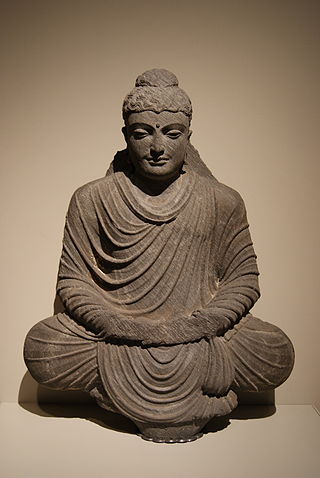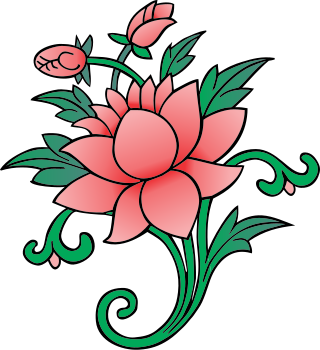Related Research Articles
The Bodhisattvacaryāvatāra or Bodhicaryāvatāra translated into English as A Guide to the Bodhisattva's Way of Life, is a Mahāyāna Buddhist text written c. 700 AD in Sanskrit verse by Shantideva (Śāntideva), a Buddhist monk at Nālandā Monastic University in India which is also where it was composed.

Chögyam Trungpa, formally named the 11th Zurmang Trungpa, Chokyi Gyatso, was a Tibetan Buddhist master and holder of both Kagyu and Nyingma lineages of Tibetan Buddhism. He was recognized by both Tibetan Buddhists and other spiritual practitioners and scholars as a preeminent teacher of Tibetan Buddhism. He was a major figure in the dissemination of Buddhism in the West, founding Vajradhatu and Naropa University and establishing the Shambhala Training method. The 11th of the Trungpa tülkus, he was a tertön, supreme abbot of the Surmang monasteries, scholar, teacher, poet, artist, and originator of Shambhala Buddhist tradition.

Pema Chödrön is an American-born Tibetan Buddhist. She is an ordained nun, former acharya of Shambhala Buddhism and disciple of Chögyam Trungpa Rinpoche. Chödrön has written several dozen books and audiobooks, and was principal teacher at Gampo Abbey in Nova Scotia until recently. She retired in 2020.

Ānāpānasati, meaning "mindfulness of breathing", is the act of paying attention to the breath. It is the quintessential form of Buddhist meditation, attributed to Gautama Buddha, and described in several suttas, most notably the Ānāpānasati Sutta.

In Mahayana Buddhism, bodhicitta is the mind (citta) that is aimed at awakening (bodhi) through wisdom and compassion for the benefit of all sentient beings.

Dilgo Khyentse Rinpoche, Tashi Paljor was a Vajrayana master, Terton, scholar, poet, teacher, and recognized by Buddhists as one of the greatest realized masters. Head of the Nyingma school of Tibetan Buddhism from 1988 to 1991, he is also considered an eminent proponent of the Rime tradition.

Gampo Abbey is a Western Buddhist monastery in the Shambhala tradition in Nova Scotia, Canada on the edge of the Pleasant Bay community. Founded by Chögyam Trungpa Rinpoche in 1983, it is a lineage institution of Shambhala and a corporate division of the Vajradhatu Buddhist Church of Canada.
Spiritual materialism is a term coined by Chögyam Trungpa in his book Cutting Through Spiritual Materialism. The book is a compendium of his talks explaining Buddhism given while opening the Karma Dzong meditation center in Boulder, Colorado. He expands on the concept in later seminars that became books such as Work, Sex, Money. He uses the term to describe mistakes spiritual seekers commit which turn the pursuit of spirituality into an ego-building and confusion-creating endeavor, based on the idea that ego development is counter to spiritual progress.
Shambhala Publications is an independent publishing company based in Boulder, Colorado. According to the company, it specializes in "books that present creative and conscious ways of transforming the individual, the society, and the planet". Many of its titles deal with Buddhism and related topics in Eastern studies, religion, philosophy, and martial arts. The company's name was inspired by the Sanskrit word Shambhala, referring to a mystical kingdom hidden beyond the snowpeaks of the Himalayas, according to the Tibetan Buddhist tradition. Its authors include Chögyam Trungpa, Pema Chödrön, Thomas Cleary, Ken Wilber, Fritjof Capra, A. H. Almaas, John Daido Loori, John Stevens, Edward Espe Brown and Natalie Goldberg.

Sakyong Jamgon Mipham Rinpoche, Jampal Trinley Dradül, born Ösel Rangdröl Mukpo, is a Tibetan Buddhist master and holder of the Sakyong Lineage of Mukpodong, his family lineage. The Sakyong was recognized by Penor Rinpoche in 1995 as the tülku (reincarnation) of Ju Mipham Gyatso, the renown Rimé teacher of the late 19th century who stated he would only be reborn in the legendary Kingdom of Shambhala.
Judith Simmer-Brown is a Distinguished Professor of Contemplative and Religious Studies Emerita at Naropa University. She has expertise in Tibetan Buddhism, Women and Buddhism, Buddhist-Christian dialogue, Western Buddhism and Contemplative Education. She is an acharya — a senior Buddhist teacher — in the Shambhala Buddhist tradition and was a senior student of Chögyam Trungpa Rinpoche. She serves on the board of the Society of Buddhist-Christian Studies, and is on the steering committee of the Contemplative Studies Group of the American Academy of Religion. Previously she was a member of the Lilly Buddhist-Christian Theological Encounter.
Lojong is a contemplative practice in the Tibetan Buddhist tradition which makes use of various lists of aphorisms or slogans which are used for contemplative practice. The practice involves refining and purifying one's motivations and attitudes. There are various sets of lojong aphorisms; the most widespread text in the Sarma traditions is that of Chekawa Yeshe Dorje. There is also another set of eight lojong slogans by Langri Tangpa. In the Nyingma tradition, there is a list of seven lojong slogans which are part of the Dzogchen Nyingthig lineage.

Lion's Roar is an independent, bimonthly magazine that offers a nonsectarian view of "Buddhism, Culture, Meditation, and Life". Presented are teachings from the Buddhist and other contemplative traditions, with an emphasis on applying the principles of mindfulness and awareness practices to everyday life.

Shambhala Training is a secular approach to meditation and a new religious movement developed by Tibetan Buddhist teacher Chögyam Trungpa Rinpoche and his students. It is based on what Trungpa calls Shambhala Vision, which sees enlightened society as not purely mythical, but as realizable by people of all faiths through practices of mindfulness/awareness, non-aggression, and sacred outlook.
Contemplative psychotherapy is an approach to psychotherapy that includes the use of personal contemplative practices and insights informed by the spiritual tradition of Buddhism. Contemplative psychotherapy differs from other, more traditional methods of counseling in that the therapist brings to the therapeutic relationship qualities of mindfulness and compassion in order to help clients access their fundamental goodness and natural wisdom. The practice of Contemplative Psychotherapy grew out of a dialogue between Tibetan Buddhist master Chogyam Trungpa Rinpoche and Western psychologists and psychiatrists. This discussion led to the opening of the Contemplative Psychotherapy Department at Naropa University in 1978 by Edward M. Podvoll, a psychiatrist, psychoanalyst and dedicated student of Trungpa.
The term spiritual warrior is used in Tibetan Buddhism for one who combats the universal enemy: self-ignorance (avidya), the ultimate source of suffering according to Buddhist philosophy. Different from other paths, which focus on individual salvation, the spiritual warrior's only complete and right practice is that which compassionately helps other beings with wisdom. This is the Bodhisattva ideal, the spiritual warrior who resolves to attain buddhahood in order to liberate others. The term is also used generically in esotericism and self-help literature. Spiritual warrior, "illuminated heart and valiant one", "enlightenment hero", "one who aspires for enlightenment" or, "heroic being" has been defined as a bodhisattva.

Universal Compassion: Inspiring Solutions for Difficult Times, Tharpa Publications ISBN 978-0-948006-72-2 is a commentary to Geshe Chekhawa's Training the Mind in Seven Points by Geshe Kelsang Gyatso, a Buddhist teacher and author in the West.

Khenpo Gangshar Wangpo was a highly respected lama in Eastern Tibet and one of the primary teachers of Chögyam Trungpa Rinpoche and the 9th Thrangu Rinpoche. Khenpo Gangshar was trained in Shechen Monastery, a monastic center established in the end of the seventeenth century and part of the Mindröling lineage within the Nyingma tradition of Tibetan Buddhism.
This is a list of works published by Pema Chödrön, buddhist nun and student of Chögyam Trungpa Rinpoche. An author and acharya, Chödrön was a senior teacher of the Shambhala Buddhist lineage Trungpa founded. She has been the resident teacher and founding director of Gampo Abbey in Nova Scotia since 1984.
In the Nyingma Tibetan Buddhist Dharma teachings faith's essence is to make one's being, and perfect dharma, inseparable. The etymology is the aspiration to achieve one's goal. Faith's virtues are like a fertile field, a wishing gem, a king who enforces the law, someone who holds the carefulness stronghold, a boat on a great river and an escort in a dangerous place. Faith in karma causes temporary happiness in the higher realms. Faith is a mental state in the Abhidharma literature's fifty-one mental states. Perfect faith in the Buddha, his Teaching (Dharma) and the Order of his Disciples (Sangha) is comprehending these three jewels of refuge with serene joy based on conviction. The Tibetan word for faith is day-pa, which might be closer in meaning to confidence, or trust.
References
- ↑ Drolma, Lama Palden (May 28, 2019). Love on Every Breath: Tonglen Meditation for Transforming Pain into Joy. New World Library. p. 4. ISBN 978-1608685769.
- ↑ Trungpa, Chogyam (April 8, 2013). The Tantric Path of Indestructible Wakefulness: The Profound Treasury of the Ocean of Dharma, Volume Three. Shambhala. p. 701. ISBN 978-1590308042.
- 1 2 3 4 5 Rinpoche, Patrul (July 12, 2010). Words of My Perfect Teacher: A Complete Translation of a Classic Introduction to Tibetan Buddhism (Revised ed.). Yale University Press. p. 222. ISBN 978-0300165326.
- 1 2 3 4 5 6 "Tonglen - Giving and Taking Meditation". viewonbuddhism.org. Retrieved 2024-02-18.
- ↑ "Pema Chödrön "Tonglen Meditation"". YouTube. Jul 24, 2009. Archived from the original on 2021-11-18. Retrieved September 10, 2015.
- ↑ Trungpa, C.; Lief, J.L.; Nalanda Translation Committee (2005). Training the Mind & Cultivating Loving-kindness. Shambhala Library. Shambhala. ISBN 978-1-59030-252-1 . Retrieved 2024-05-13.
- ↑ "Tonglen". Interlude: An Internet Retreat. Retrieved September 10, 2015.
- ↑ "The Practice of Tonglen". Pema Chodron . Retrieved September 10, 2015.
- ↑ Trungpa, Chögyam (2003). Training the Mind and Cultivating Loving-Kindness. Shambhala Publications. p. xi. ISBN 9781590300510.
- 1 2 Lief, Judy. "Learn to Train Your Mind: The 59 Lojong Slogans with Acharya Judy Lief". Tricycle: The Buddhist Review . Retrieved September 10, 2015.